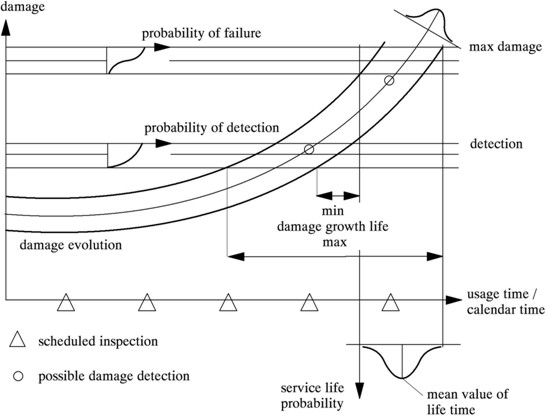
engineering & technology publications
ISSN 1759-3433
PROCEEDINGS OF THE EIGHTH INTERNATIONAL CONFERENCE ON COMPUTATIONAL STRUCTURES TECHNOLOGY
Damage Tolerant Design
Institute of Structural Mechanics, Bauhaus-Universität Weimar, Germany
The deterioration of a structure is associated with both the initial manufacturing quality and the service usage. A slight variation in the manufacturing quality of new structures can lead to substantial differences in their life spans. In service, the hostile environment, operational as well as overloading or accidental loading and careless usage are responsible for degradation. Prediction of the exact limit state in terms of capacity and life is improbable. On the other side, the damage detection is subjective to the inspection program, i.e., inspection scheduling, detection technique and the inspector quality. Whatever the inspection tool may be, there is a probability of detection (POD) associated with damage type, size, location, orientation, and so on. There is a need to synthesize these seemingly deterministic probability distributions.
The damage tolerant concept taking into account stochastic scatter of input variables can be seen in a graphical representation in Figure 1. Here bands describing the stochastic scatter of data, characterize the damage evolution, the probability of detection and the probability of failure. The intersections therewith become intersection areas with complex probabilistic distributions. We can now distinguish between the minimum and the maximum damage growth life, with the first defined as the minimum time period between latest possible detection and first possible structural failure, the latter defined as the maximum time period between first possible detection of failure and latest possible structural failure.
The presented approach of a software framework for the risk-assessment of engineering structures, named CORAL [1,2] allows design and maintenance management engineers to quantitatively judge on inspection and maintenance programs for their structures. Damage initiation and evolution can be included in the framework in a very flexible manner, by external special purpose software packages or by experimental results. Costs associated with downtime and repair as well as earnings associated with operation of investigated structures can be taken into account. The proposed framework can be conveniently applied to predict the outcome of maintenance management plans in terms of probability of failure, fatal accident rate, monetary expense, downtime periods and costs, availability, reliability and so on. The ability to correlate the cost and estimate the impact of a maintenance management plan has not been attempted before. When coupled with an optimization algorithm, CORAL can help managers arrive at the most economic maintenance management plan for a desired safety level.
- 1
- Könke, C. "Schädigungssimulationsverfahren zur Lebensdauerabschätzung von Tragwerken" in Mitteilungen des Lehrstuhls für Baustatik und Baudynamik, RWTH Aachen, Heft 00/2., 2000.
- 2
- Singh, R, Könke, C., "Simulation framework for risk assessment of damage tolerant structures", Computers & Structures, 77 (2000), pp.101-115, 2000. doi:10.1016/S0045-7949(99)00200-X
purchase the full-text of this paper (price £20)
go to the previous paper
go to the next paper
return to the table of contents
return to the book description
purchase this book (price £140 +P&P)
